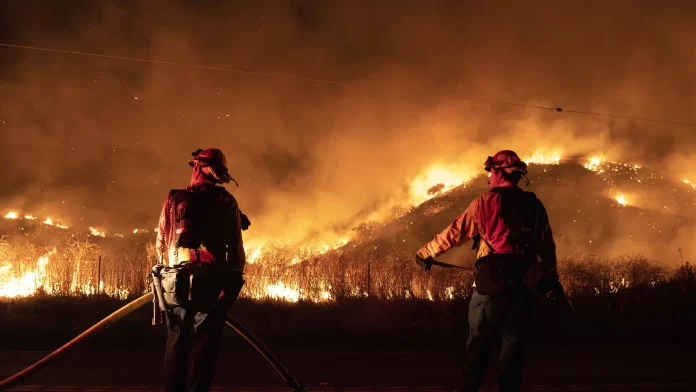Mirna Fahmy – Diplomatic Inside
In the technology revolution, AI can be utilised to detect wildfires, the most disastrous climate change, and subside their destruction as much as possible.
Wildfires have been a significant climate disaster in recent decades because of the heatwaves that span their locations, inflicting major problems. Climate change is at the core of this inflicting natural phenomenon. It has led to warmer temperatures, extended droughts, and shifting precipitation patterns that are creating drier and more flammable conditions that allow wildfires to start more easily and spread more rapidly.
According to the US Global Change Research Programme, climate change has already led to an increase in wildfire season length, wildfire frequency, and the extent of burned areas.
As a result, recent years have seen a shift in the peak from August to July, resulting in earlier and longer fire seasons. This extends the period of high fire risk.
Earlier this year, the United Nations (UN) forecast a global increase in extreme fires of up to 30 percent by the end of 2050 and 50 percent by the end of the century.
Another environmental issue besides climate change is “lightning strikes.” Rising temperatures are expected to increase the frequency of lightning strikes, which are a major cause of ignition for wildfires, especially in remote areas.
Human activities are too severely blamed, as they are the factors that led to the expansion of wildfires, such as the Wildland-Urban Interface. The expansion of human development into fire-prone wildland areas increases the risk of ignition sources and the potential for damage to structures. This wildland-urban interface is growing by about 2 million acres per year in the U.S.
An increased fuel load is also an intriguing human factor. Decades of fire suppression have led to a buildup of dry vegetation and fuel in many forest areas, particularly in the western United States. This provides more combustible material for wildfires to spread.
The rage of the wildfires has been wildly seen, mainly across three regions. Boreal forests, which are in the north of the planet in countries like Alaska, Canada, Scandinavia, and Russia, are becoming increasingly vulnerable to wildfires. Mediterranean regions like Portugal, Spain, Italy, Greece, and France are currently the most prone to wildfires in Europe. The Western United States, including states like California, is facing a growing wildfire threat due to climate change.
Wildfires have killed the biodiversity of nature and evacuated thousands of people from their homes so that they wouldn’t die from the killing smoke or burn alive if these wildfires sprawled further. The energy to put down the outraging fires has doubled, no matter how much force is poured into aerial firefighting that require using helicopters and known as well as “waterbombing”. Not to mention, wildfires are not easily expected to happen at any time.
As much as using technology tools to forecast the mood of the weather, artificial intelligence (AI) is playing a crucial role in revolutionising wildfire prediction and management. AI-powered systems can analyse vast amounts of satellite imagery, aerial data, and real-time sensor information to detect and track wildfires. This enables early detection and rapid response to potential wildfires.
AI algorithms can monitor the spread of fires in real-time, providing valuable insights to emergency responders and helping them make informed decisions. AI also aids in predicting fire behaviour by analysing historical data and current environmental conditions such as weather patterns, fuel moisture levels, and topography. This information is invaluable for planning evacuation routes, allocating resources, and minimising the impact of wildfires.
AI is employed in the development of early warning systems. By analysing real-time data from sensors, satellites, and weather stations, AI algorithms can detect the presence of wildfires in their early stages, allowing for faster response times. AI is also used to enhance fire detection and monitoring through the analysis of satellite imagery and aerial data.
By doing so, these AI warning alerts can instigate the extinguishing of factors that might lead to wildfires in their early stages. Ensuring that campfires, fire pits, and other open flames are completely extinguished when not in use is crucial, especially on a windy day. Making sure of the disposal of smoking materials such as cigarettes and matches.
Careful use of flammable liquids will be more taken into consideration. When using propane, gasoline, or other flammable liquids, exercising extreme caution will have to be practised, allowing equipment to fully cool before refuelling to prevent accidental ignitions.
Challenges and Limitations
Traditional wildfire prediction methods face challenges due to reliance on historical data, limited spatial and temporal resolution, difficulty integrating real-time data, oversimplification of wildfire dynamics, uncertainty, and issues with inadequate communication and coordination. While AI offers potential solutions to improve accuracy and effectiveness in wildfire prediction and management, there are still limitations to be addressed. That’s why the quality of the data has to be updated regularly to alert AI about the changes and provide helpful results.
One major limitation of AI-mediated wildfire management is the lack of realistic modelling methodologies that suit the needs of multiple landscapes across the world. Additionally, sophisticated knowledge, high-quality parameters about forests, and better AI algorithms that correlate available data are also lacking. With high-resolution data and sophisticated algorithms, AI-powered machines can certainly circumvent the emergence and spread of forest fires.


